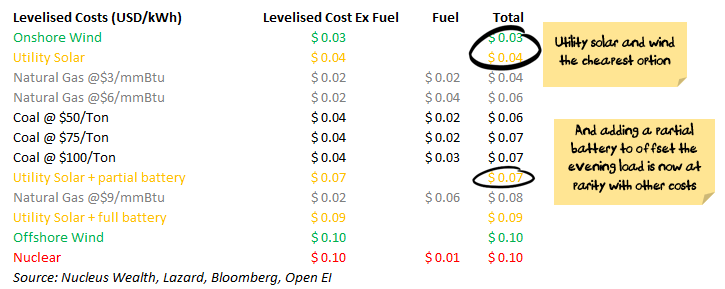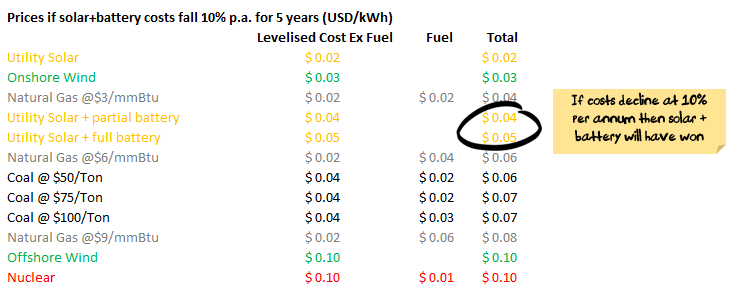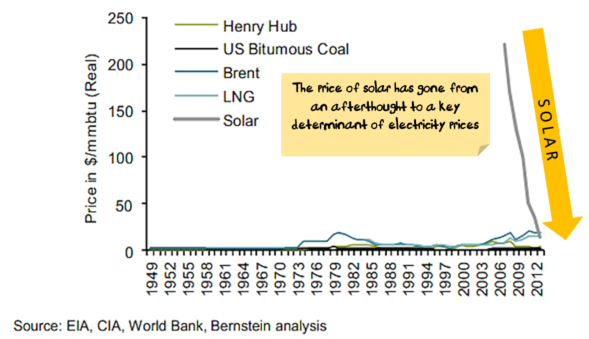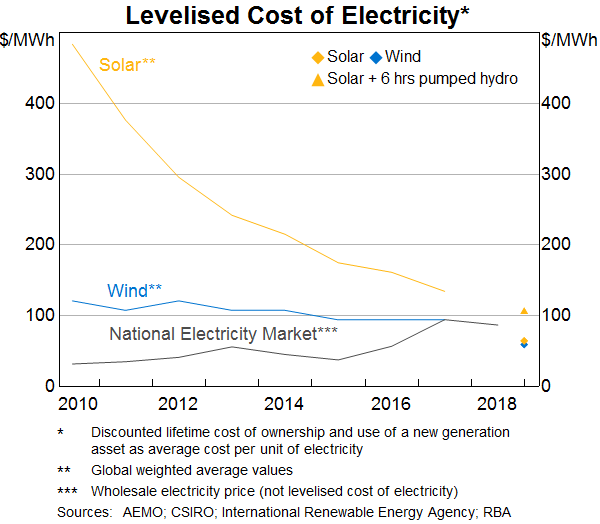The RBA was out last night discussing climate change and posted the following chart of energy costs which confirms our view that it is game over for coal:
These numbers are largely in line with our numbers on electricity costs from various sources and since it has been over a year since I last posted my numbers on electricity costs and so I thought it worth updating.
The headline: costs keep falling and energy parity is here. Electricity prices are coming down over the medium term from here.
Our basic investment thesis is that coal, gas, oil, all have economics based on a “scarcity curve” – the more we use them, the deeper we need to dig to find more and more expensive they become to extract. Solar and battery power is on a “technology curve” the more the world produces, the cheaper it becomes.
Our view is we will reach an energy parity where technology curve become an upper bound for the scarcity curve – the price of energy won’t exceed the cost of Solar+Batteries. Solar+Batteries are the “killer app” – extremely scalable once they reach an acceptable cost. And we are basically there.
I separate the technology costs from the fuel costs to show the sensitivity to gas and coal costs (note that the below numbers are in USD for international comparability vs AUD in the RBA’s chart above). A partial battery below is enough to cover most of the evening load, a full battery is for round the clock power. All numbers are approximate, with lots of assumptions:

Costs have been falling at 20% per annum, but even if the cost improvements slowed to 10% per annum, coal is cooked as an option – in 5 years time even a full battery beats coal on cost:

And just to remind you of the longer term picture:

Rooftop Solar
I have deliberately left Rooftop Solar out of the above tables, as they are less comparable than you would think. Roof-top solar has costs of around $0.13 which is much higher than the costs above.
But that is not important. Rooftop solar is not competing with a coal plant, or even with utility solar.
Rooftop solar is competing with grid power + grid infrastructure. It is an important distinction.
I don’t care whether my rooftop solar produces cheaper than the local coal-fired power station, I care whether it produces at a cheaper rate than I pay for power – and it does:

The issue is that my panels produce power during the day when everyone else’s panels are also producing power, and so unless I use it myself to offset the above charge, I get paid a fraction of what the power company will charge my neighbour for using my spare electricity. Also, the peak rate (in the evening) for time of day pricing is much higher than during the day.
At $0.31 for partial shifting (which is basically generating enough power to get you through the evening peak), having some batteries is profitable for anyone on time of day charges. A lot of this price comes from the discount rate, so if you are prepared to accept a lower return (and lock in electricity prices) then partial shifting can be worth it at current prices.
But batteries aren’t quite a “no brainer” cheaper option.
Looking at the 10% cost reduction scenario again:

There are lots of questions that the above table raises. If everyone starts going off-grid who pays for the poles and wire, do we end up in a death spiral where more people leave the grid, raising the cost for those who remain which means more people leave and so on.
All valid questions.
My best bet is that it is going to be a battle of vested interests. Richer people will leave the grid when it becomes economic (as they can afford the upfront cost), leaving renters and the poor left paying higher bills to account for the transmission assets. Governments will have three options:
- Prevent retail electricity price rises, stand up for the poor and make the asset owners pay the cost of their mistaken investment
- Socialise the losses and bail out the transmission asset owners
- Let the asset owners raise prices, shift the cost of adjustment onto the poor
While option 1 would be my preferred choice, I have a sinking feeling that option 3 will be the path of least resistance. The lobbyists will no doubt be hard at work on option 2 in case any government have the fortitude to explore option 1.
————————————-
Damien Klassen is Head of Investments at the Macrobusiness Fund, which is powered by Nucleus Wealth.
The information on this blog contains general information and does not take into account your personal objectives, financial situation or needs. Past performance is not an indication of future performance. Damien Klassen is an authorised representative of Nucleus Wealth Management, a Corporate Authorised Representative of Integrity Private Wealth Pty Ltd, AFSL 436298.
